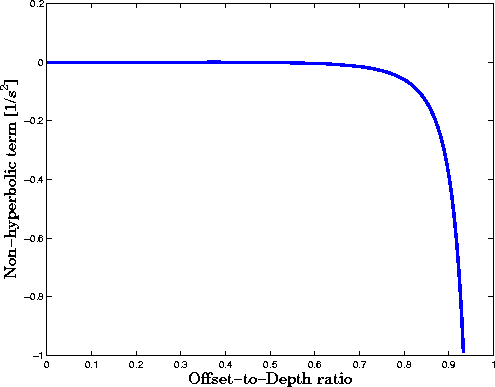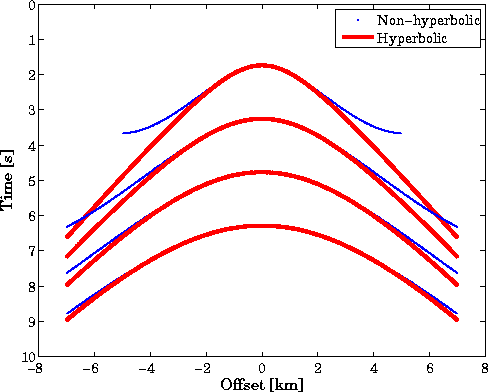A seismic trace represents a signal d(t) recorded
at a constant location x. The normal moveout operator
transforms a trace into a ``vertical propagation'' signal,
![]() , by stretching t into
, by stretching t into ![]() Claerbout (1999).
For conventional PP seismic processing
the NMO transformation is generally described as a hyperbola.
For PS waves the traveltime moveout does not approximate a
hyperbola for large values of offset-to-depth ratio even for
an Earth's model consisting on horizontal layers embedded in a
constant P and S velocities.
Claerbout (1999).
For conventional PP seismic processing
the NMO transformation is generally described as a hyperbola.
For PS waves the traveltime moveout does not approximate a
hyperbola for large values of offset-to-depth ratio even for
an Earth's model consisting on horizontal layers embedded in a
constant P and S velocities.
One of the main characteristic of converted-wave data is their non-hyperbolic moveout in CMP gathers. However, for certain values of offset-to-depth ratio, it is possible to approximate the non-hyperbolic moveout in a CMP gather to a hyperbola Tessmer and Behle (1988).
Castle (1988) developed a non-hyperbolic moveout equation
for converted-wave data. This equation consists on three
coefficients instead of the two coefficients for the hyperbolic
equation. Castle's 1988 non-hyperbolic moveout equation
is a function of both the P-velocity and the S-velocity.
Next, I present an expression for the
non-hyperbolic moveout equation in terms of ![]() .
.
Equation ![[*]](http://sepwww.stanford.edu/latex2html/cross_ref_motif.gif) is the third-order approximation for the
total traveltime function
of reflected PP or SS data presented by Taner and Koehler (1969):
is the third-order approximation for the
total traveltime function
of reflected PP or SS data presented by Taner and Koehler (1969):
| t2 = c1 + c2 x2 + c3 x4, | (1) |
| (2) |
For the second order approximation of the total traveltime function, Tessmer and Behle (1988) show that the first coefficient, c1, is simplified as
 |
(3) |
 |
(4) |
The third coefficient, as presented by Castle (1988), is
 |
(5) |
![[*]](http://sepwww.stanford.edu/latex2html/cross_ref_motif.gif) simplifies to
simplifies to
![\begin{displaymath}
c_3 = \frac{z^2 \left [ (v_p+v_s)^2 - (\frac{1}{v_p} + \frac{1}{v_s})(v_p^3 + v_s^3) \right ]}{4 z^4 (v_p+v_s)^4},\end{displaymath}](img14.gif) |
(6) |
 |
(7) |
![[*]](http://sepwww.stanford.edu/latex2html/cross_ref_motif.gif) represents the simplification for the third coefficient (c3)
as a function of both the P-velocity and the S-velocity.
However, equation
represents the simplification for the third coefficient (c3)
as a function of both the P-velocity and the S-velocity.
However, equation ![[*]](http://sepwww.stanford.edu/latex2html/cross_ref_motif.gif) can be rewritten using the results of
equation
can be rewritten using the results of
equation ![[*]](http://sepwww.stanford.edu/latex2html/cross_ref_motif.gif) and
and ![[*]](http://sepwww.stanford.edu/latex2html/cross_ref_motif.gif) , that is,
, that is,
| |
(8) |
|
nhterm
Figure 1 Non-hyperbolic term as a function of the offset-to-depth ratio. |  |
The coefficient c3 is the term in the total traveltime function that
controls the non-hyperbolicity characteristic for PS reflections.
Figure ![[*]](http://sepwww.stanford.edu/latex2html/cross_ref_motif.gif) plots equation
plots equation ![[*]](http://sepwww.stanford.edu/latex2html/cross_ref_motif.gif) ,
as a function of the offset-to-depth ratio.
Notice that the non-hyperbolicity is primarily observed for
large values of the offset-to-depth ratio, this conclusion validates the assumption
of Tessmer and Behle (1988), that is the non-hyperbolic moveout can be approximated with
a hyperbola for small values of the offset-to-depth ratio. Also, note that the correction
is always negative and ignoring it will result in overestimates values for the velocities.
,
as a function of the offset-to-depth ratio.
Notice that the non-hyperbolicity is primarily observed for
large values of the offset-to-depth ratio, this conclusion validates the assumption
of Tessmer and Behle (1988), that is the non-hyperbolic moveout can be approximated with
a hyperbola for small values of the offset-to-depth ratio. Also, note that the correction
is always negative and ignoring it will result in overestimates values for the velocities.
Substituting equations ![[*]](http://sepwww.stanford.edu/latex2html/cross_ref_motif.gif) ,
, ![[*]](http://sepwww.stanford.edu/latex2html/cross_ref_motif.gif) and
and ![[*]](http://sepwww.stanford.edu/latex2html/cross_ref_motif.gif) into
the total traveltime equation
into
the total traveltime equation ![[*]](http://sepwww.stanford.edu/latex2html/cross_ref_motif.gif) , I obtain the non-hyperbolic
moveout equation for PS data
, I obtain the non-hyperbolic
moveout equation for PS data
| |
(9) |
![[*]](http://sepwww.stanford.edu/latex2html/cross_ref_motif.gif) depends only on two parameters: 1) the effective velocity (
depends only on two parameters: 1) the effective velocity (![[*]](http://sepwww.stanford.edu/latex2html/cross_ref_motif.gif) ) reduces to the conventional hyperbolic normal moveout
equation. This equation also assumes a single layer model.
) reduces to the conventional hyperbolic normal moveout
equation. This equation also assumes a single layer model.
Figure ![[*]](http://sepwww.stanford.edu/latex2html/cross_ref_motif.gif) shows the traveltime computed with
equation
shows the traveltime computed with
equation ![[*]](http://sepwww.stanford.edu/latex2html/cross_ref_motif.gif) , with a constant P-velocity of 2 km/s, and S-velocity
of 0.6 km/s, a maximum absolute offset of 7 km, and four horizontal reflectors
at depths of 0.8, 1.5, 2.2, 2.9 km. The dotted curve represents non-hyperbolic
moveout, equation (
, with a constant P-velocity of 2 km/s, and S-velocity
of 0.6 km/s, a maximum absolute offset of 7 km, and four horizontal reflectors
at depths of 0.8, 1.5, 2.2, 2.9 km. The dotted curve represents non-hyperbolic
moveout, equation (![[*]](http://sepwww.stanford.edu/latex2html/cross_ref_motif.gif) ), and the solid curve represents the hyperbolic
moveout equation, that is omitting the third term in equation (
), and the solid curve represents the hyperbolic
moveout equation, that is omitting the third term in equation (![[*]](http://sepwww.stanford.edu/latex2html/cross_ref_motif.gif) ).
Observe that for deeper reflectors and small offset both curves match
reasonably well.
).
Observe that for deeper reflectors and small offset both curves match
reasonably well.
|
nhnmo
Figure 2 Non-hyperbolic traveltime comparison with the hyperbolic approximation. |  |